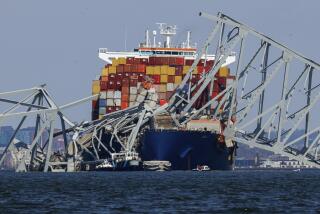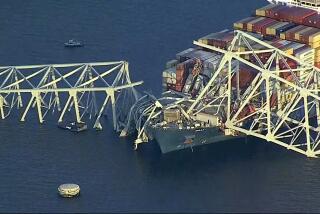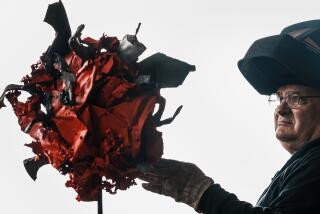Mostar Tries to Piece Together Bosnia’s Broken Dream
- Share via
MOSTAR, Bosnia-Herzegovina — With enough faith, it is possible to look at the limestone rubble of this city’s old bridge and see things as they were.
The ruins lie scattered on a riverside platform where Hungarian soldiers set them down with a 90-ton crane after raising the stones from the Neretva River.
They are 158 pieces of a broken dream--some say a myth--of a united Bosnia, but most of Mostar’s people are determined to restore the centuries-old bridge destroyed by Croatian soldiers in 1993.
By wrecking one of the most enduring symbols of Bosnian unity--the Stari Most, which means Old Bridge and gave Mostar its name--the city’s attackers thought they could crush the morale of its defenders. They failed, and Mostar survived to celebrate peace two years later.
French and Spanish troops now keep residents from the Muslim-dominated east and the Croat-dominated west from shooting at one another, but Mostar is still divided by hatred and mistrust.
Its survivors hope that resurrecting the bridge will prove that anything is possible--even the vision of Muslims and Croats living together again without fear.
Fear of Raising False Hopes
The project is a risky, $14-million enterprise that could just as well revive old hatreds, raise false hopes and leave Mostar with monumental proof that there is no way back.
Colin Kaiser, a U.N. official overseeing the bridge’s restoration, realized what he was up against when he saw the first, 5-ton chunk of stone hauled out of the river on Sept. 29, 1997, in front of thousands who had survived the fighting here during 3 1/2 years of war.
Over a four-year period, the powerful Neretva had reworked the stones, and the stones had rerouted the river, which may have eroded the banks and undermined the foundations of the bridge’s Tara and Halebija towers.
“The local people thought that the bridge was kind of sleeping under the water,” said Kaiser, a Canadian who heads the U.N. Educational, Scientific and Cultural Organization, or UNESCO, mission here. “When we started pulling it out, they began to understand: It’s not going to be easy.”
Experts are just beginning to determine how much of the Stari Most can be saved and how many years it’s going to take. Many of Mostar’s people are in a hurry. They want proof that the multiethnic Bosnia-Herzegovina of old can be reclaimed. Now.
While they watch and try to will the builders to succeed, others are waiting and praying that the Stari Most--and the Bosnia it stood for--are gone forever.
To help reduce the risk of failure, the World Bank and UNESCO are guaranteeing funds for the project and backing an international panel of experts that met last month to start planning each step of the bridge’s restoration.
The experts are searching archives in Istanbul, Turkey, and Sarajevo, the Bosnian capital, for drawings and other records. They are studying the old lead and iron joints, even analyzing the mortar and stones to match the original ingredients and cutting tools.
In 1566, Ottoman architect Mimar Hajrudin bridged the Neretva River, linking east and west with stones held together by mortar mixed from gypsum, horsehair and eggshells.
Legend has it that just as the builders were taking down the scaffolding, Hajrudin fled the city for fear that the structure was about to crumble into the river.
It not only stood, it became a world landmark. The United Nations has been asked to declare the ruins and Mostar’s old town a World Heritage site, which would put them in such celebrated company as the Acropolis and the Statue of Liberty.
A Working Piece of Art
More than just a bridge, the Stari Most was a work of art, a graceful arch almost 90 feet high that joined the twin towers and created a link that was central to the city’s culture. A boy in Mostar was not considered a man until he had jumped from the bridge into the swirling jade waters of the Neretva.
Millions of footsteps and centuries of rolling wooden carts wore the rutted stones so smooth that they glistened like polished marble. As warriors came and went, people endured, and the bridge became a symbol of Croats, Serbs and Muslims living together in Bosnia.
Then war came again in 1992.
The conflict, triggered by Bosnia’s declaration of independence from the crumbling Yugoslav federation, pitted Muslims against Croats and both against Serbs. During their drive to seize all of Mostar, Croatian soldiers fired 100-millimeter tank rounds into the bridge for two days, searching for its breaking point. On the morning of Nov. 9, 1993, the ancient stone finally gave out.
Safet Orucevic, a broad-shouldered man with a nose that says he doesn’t back down easily, was a fighter on the east bank of the Neretva when Croatian forces were attacking from the west bank.
He was asleep in the remnants of a house about 300 feet from the bridge when it collapsed in a cloud of gray smoke.
Orucevic got up to see what was left, and, as he stared into the gap his Croatian enemies had blasted between east and west, he made himself a quiet promise.
“I said, ‘If I stay alive, the biggest confirmation that we have been saved will be the reconstruction of that bridge.’ It was a big shock that the bridge had been destroyed.
“The destruction was supposed to cause the total collapse of our morale, but it had the opposite effect. There was a spite that was born, a spite for survival.”
After the Bosnian war ended in December 1995, Mostar was reunited--on paper. Orucevic became mayor, and the old bridge’s fate passed into his hands.
He turned down two foreign offers to immediately rebuild the bridge. He wanted Bosnian Muslims, Croats and Serbs to restore the link together.
It took Orucevic years of haggling to win Croatian agreement to join the project. It came last month from Ivan Prskalo, a Croatian leader and now Mostar’s mayor.
With the city’s severely damaged factories running at less than 10% capacity and the rate still falling, Prskalo thinks Mostar’s people need jobs more than a restored ruin. But he backed the project after winning a promise that Croats will get their share of the reconstruction work, which struck more than a few of Mostar’s people as extortion.
Orucevic accepted Prskalo’s terms anyway. Ethnicity makes no difference as long as a worker knows his job, said Orucevic, who is now deputy mayor.
“For 500 years, church bells have been heard here, and the muezzin’s call to prayer from the mosque,” Orucevic said. “We have a synagogue in town. And all that is within 100 yards of the bridge.
“Mostar was the city with the largest number of mixed marriages in former Yugoslavia. So the town has multiethnic tolerance in its blood. None of us [Muslims] born in Mostar cannot find a Serb or Croat in his family, and vice versa.”
The old bridge that used to unite Mostar was difficult to break because its 16th century builders locked the stones tightly together with iron and lead clamps.
Kaiser fears that the Croats’ shells pounded the stones so hard that there is much less material worth recovering than first thought. Only 20% of the bridge has been raised so far, and the salvage effort has stopped for the winter. It will resume in April.
Three or four huge sections still in the river may be in better shape, but only tests will show whether shell blasts and raging water also rendered them useless.
“One of the reasons we stopped pulling them out was that we needed a 120-ton crane and the one we had was only 90 tons,” Kaiser said. “I think another reason was that they [Mostar residents] began to get discouraged, looking at this stone and wondering: ‘What are we going to do with it?’ That’s a fundamental problem.”
Kaiser is confident that at least some of the old bridge can be used in reconstruction.
Local people think that they know where the original stones for constructing the bridge were quarried, and 9,000 cubic feet of limestone have been cut from the site. In their rush, workers cut against the grain, so even the new stone is probably useless.
The original paving stones, meanwhile, were quarried from a place now in Republika Srpska, the Serb-controlled portion of Bosnia-Herzegovina, whose leaders usually avoid cooperating at all costs with the uneasy Muslim-Croat federation that rules the other 51% of Bosnia.
Kaiser believes that problem can be resolved with negotiations. But there is another asymmetry that may not be so easily solved. It was a flaw in the arch of the old bridge itself, probably the result of a builder’s error.
The experts will have to decide, under close monitoring by representatives of Bosnia’s ethnic communities, whether the mistake is worth trying to repeat.
“You’ve got to build it right because if you don’t, it’s like destroying the bridge twice,” Kaiser said.
A City United in Name Only
A return of war to Bosnia could do that too. Although Mostar has made progress since the war, it is united only in name. Peace is impossible, Orucevic said, as long as alleged war criminals from the last conflict remain at large.
Although Orucevic shares the same floor of City Hall with Prskalo, and the two are supposed to be running the same city, simply buying lunch in Croat-dominated western Mostar is proof of a different reality.
The tender of choice in western Mostar is the Croatian kuna, not the convertible mark that is Bosnia’s official currency.
Along Mostar’s former front line, where The Boulevard and The Street of the Herzegovinian Brigade meet, the ruined buildings look like toffee melting in the rain.
The site of the old Hit department store is now an enormous hole, but the store’s name lives on in a small taxi stand just across The Boulevard in mainly Muslim eastern Mostar.
Juso Maric and Sejfo Cemil, both Muslims, wait at the Hit stand each day for fares in their white Mercedes-Benz cabs and usually get just two or three. They earn less than $150 a month.
It would be easier if they could pick up fares anywhere in the city. Mainly Croatian, and more prosperous, western Mostar begins on the other side of The Boulevard. But Mostar’s cabdrivers know better than to risk hunting for passengers in enemy territory.
“There are very clear lines,” Maric said. “It’s like an invisible wall. There is progress, but it’s only very, very slow.”
More to Read
Sign up for Essential California
The most important California stories and recommendations in your inbox every morning.
You may occasionally receive promotional content from the Los Angeles Times.













